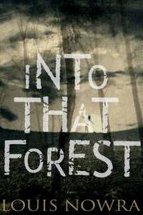Into that forest by Louis Nowra

Allen and Unwin, 2012. ISBN 9781743311646
(Ages 13+) Recommended. Children raised by animals. Two young girls,
lost in the Tasmanian bush after a boating accident, form the basis
of
this rivetting tale. Hannah has some knowledge of the bush, but the
other, Becky, has none, coming from a sheep farm where her father
and
the local bounty hunter kill all the wild dogs they can. But Hannah
is
more respectful of the tiger with the stripes and dog like features.
Her father, a whaler, has told her stories about wild animals and
she
hates the visits of the bounty hunter to their house.
The girls, about five and six years old are taken in by a pair of
Tasmanian Tigers. The girls become part of their den, learning to
hunt
with their tiger family, suckling, snuggling in with the he and she
dogs, Hannah calls Dave and Corinna, for warmth. The girls become
attuned to sleeping through the daylight hours, waking at night for
hunting and feeding, they learn to hunt in a pack, tearing at
uncooked
flesh and eating it down, lapping the water with their tongues. They
begin to lose the trappings of the life they once lead, abandoning
their clothes, forgetting their language, taking on the growls and
coughs of the animals as the form of communication.
One winter, desperately cold and starving, Hannah leads her family
to
the bounty hunter's shack, where she remembered there were sheep. It
saves their lives, but the bounty hunter now knows a pack of tigers
is
around. He kills the two new cubs, but spots the naked girls in the
bush trying to warn the mother.
An engrossing tale of family and togetherness, of familial loyalty
as
the two girls become part of the tigers' family, running with them
in
the wild, then turning to killing sheep, the one thing sure to focus
the eye of the bounty hunter on them. All the while the reader knows
a
climax is coming, one where all their loyalties will be tested.
Nowra gets into the nitty gritty of a child learning to live with
animals, which raises questions about our society and the trappings
of
civilisation which have glossed over the fundamental issues of
family
life, the basic stuff of survival, closeness, food and shelter.
This astonishing book could be compared with others like it, Dog
boy
by
Eva Hornung (2010) and the much earlier Dogboy by Victor
Kelleher
(1990) along with the stories and fables of old, Romulus and
Remus,
Mowgli, Tarzan and so on, which all have their bases
in
children being
raised in the wild. This would make an amazing text to study for
secondary readers, as the question of what is civilisation is
tantamount to any discussion of what happens in the book. The
environment, the extinction of the thylacine, the treatment of the
Aborigines in Tasmania, are all issues which could have a sound
airing
through the study of this story.
Fran Knight